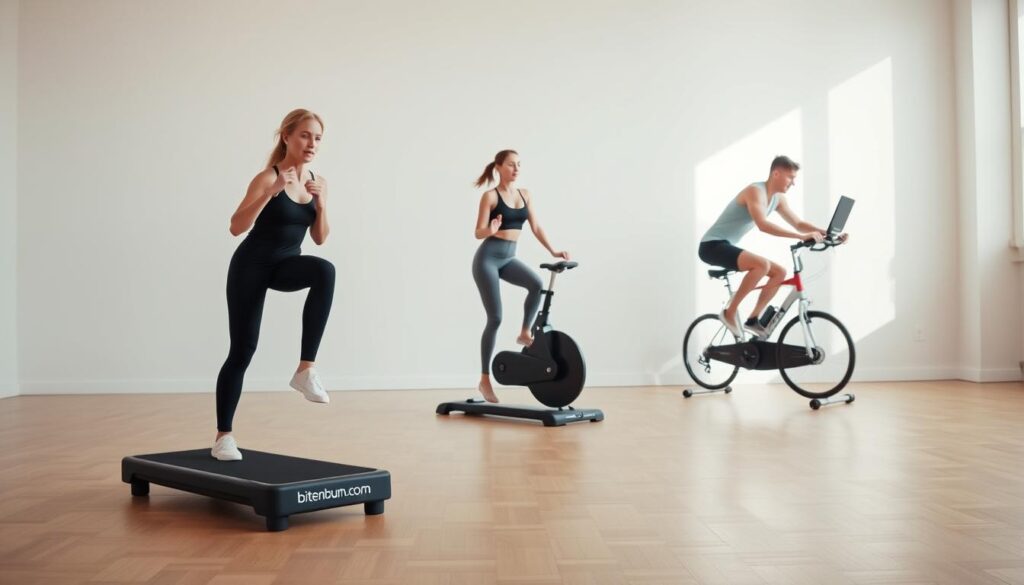Did you know that nearly 1 in 5 adults in the United States suffers from some form of arthritis or joint pain? Low-impact cardio workouts offer a solution, providing effective cardiovascular exercise while being gentle on the joints.
Low-impact exercises are particularly beneficial for individuals with joint pain or those recovering from injuries. They reduce stress on the joints, making them an ideal option for those who need to avoid high-impact activities.
We will explore how these workouts can be adapted for different fitness levels and highlight their importance in maintaining long-term joint health and mobility.
Key Takeaways
- Low-impact cardio workouts minimize stress on joints while providing effective cardiovascular exercise.
- These exercises are beneficial for individuals with joint pain, arthritis, or those recovering from injuries.
- Low-impact workouts can be adapted for different fitness levels, from beginners to advanced athletes.
- Incorporating low-impact exercises into a balanced fitness routine supports long-term joint health and mobility.
- Effective low-impact cardio workouts deliver excellent fitness results without compromising joint health.
Understanding Low-Impact Cardio Workouts for Joint Health
Understanding the mechanics of low-impact cardio is crucial for maximizing its benefits while protecting your joints. Low-impact cardio workouts are designed to reduce the stress on your joints without compromising on the cardio benefits.
What Makes a Workout “Low-Impact”?
A workout is considered “low-impact” if it involves movements where at least one foot stays on the ground or your body weight is supported, thereby reducing the impact on your joints. Examples include cycling, swimming, and using an elliptical machine.
- Reduces stress on joints
- Distributes force evenly throughout the body
- Provides effective cardio benefits
Difference Between Low-Impact and Low-Intensity
It’s essential to distinguish between low-impact and low-intensity exercises. While low-impact refers to the mechanical stress on joints, intensity relates to the cardiovascular demand. For instance, mountain climbers are a low-impact exercise that can be performed at varying levels of intensity.
By understanding this difference, individuals can tailor their workouts to meet their fitness goals and capabilities, ensuring a safe and effective exercise routine.
Benefits of Low-Impact Cardio Exercise

Low-impact cardio exercises provide a valuable alternative for individuals looking to minimize the risk of injury while improving overall fitness. These exercises are designed to reduce the stress on joints, making them an ideal choice for people of all ages and fitness levels.
Joint Protection and Reduced Injury Risk
One of the primary benefits of low-impact cardio is the protection it offers to our joints. By minimizing the repetitive stress associated with high-impact activities, we can significantly reduce the risk of injury. This is particularly beneficial for individuals with pre-existing joint conditions or those who are recovering from injuries.
Cardiovascular Health Improvements
Low-impact cardio exercises also contribute to significant improvements in cardiio health. Regular engagement in these activities can enhance heart health, increase stamina, and improve circulation without putting excessive strain on the joints. This makes them an excellent option for maintaining cardiovascular health over the long term.
Accessibility for All Fitness Levels
Another key advantage of low-impact cardio is its accessibility. These exercises can be adapted to suit various fitness levels, making them suitable for beginners, seniors, pregnant women, and individuals with existing joint issues. This inclusivity ensures that everyone can benefit from improved health and fitness without exacerbating potential health concerns.
Swimming: The Ultimate Joint-Friendly Workout

Swimming emerges as a superior choice for a joint-friendly workout due to its ability to provide a comprehensive full-body exercise with minimal stress on the body’s joints. The buoyancy of water significantly reduces the impact on joints compared to high-impact exercises like running.
Why Swimming Is Ideal for Joint Health
Swimming is ideal for joint health because it combines cardio, strength, and flexibility exercises in a low-impact environment. The water’s buoyancy supports the body, reducing pressure on the joints while allowing for effective resistance training that engages multiple muscle groups.
Effective Swimming Routines to Try
To get the most out of swimming, try incorporating different strokes such as freestyle, breaststroke, and backstroke into your routine. Each stroke targets different muscle groups, providing a well-rounded workout. For example, freestyle engages the shoulders, triceps, and quads, while breaststroke focuses on the chest and legs.
Walking: Simple Yet Powerful Low-Impact Exercise

Walking is not just a casual activity; it’s a powerful low-impact exercise for improving health. It puts less strain on your knees compared to running or jogging, making it an ideal low-impact cardio workout. By choosing the right walking surface, such as a track or trail, you can further reduce the impact on your joints.
Walking Techniques for Maximum Joint Protection
To maximize the benefits of walking while protecting your joints, focus on proper techniques. Keep your abdominals engaged, and push the ground behind you to accelerate. This helps in distributing the force evenly and reduces the impact on your joints.
How to Progress Your Walking Routine
You can progress your walking routine by incorporating intervals. Alternate between 1 to 3 minutes of walking at a faster speed with 30 to 60 seconds of walking at a slower recovery speed. This method enhances your cardio workout without adding undue stress to your body.
For more information on walking techniques and routines, visit Arthritis Foundation.
Cycling: Indoor and Outdoor Options for Joint Care

Cycling offers a versatile and low-impact way to enhance cardiovascular fitness while being gentle on the joints. Whether you prefer the structured environment of an indoor cycling class or the freedom of outdoor cycling, both options provide unique benefits for joint health.
Proper Bike Setup for Joint Protection
A proper bike setup is crucial for protecting your joints during cycling. Ensuring your bike is adjusted correctly can prevent strain on your knees, hips, and back. Your knees should remain slightly bent at their fullest extension to avoid putting excessive pressure on the joint.
Cycling Workout Ideas for Different Fitness Levels
Cycling workouts can be tailored to suit various fitness levels, from gentle recovery rides to high-intensity interval training. Beginners can start with low-resistance cycling and gradually increase intensity, while more advanced cyclists can incorporate interval training to boost cardiovascular benefits.
By adjusting resistance, cadence, and duration, cyclists can progressively increase their workout intensity without compromising joint health. This adaptability makes cycling an ideal exercise for individuals across different fitness levels.
Rowing: Full-Body Cardio Without the Impact

For those seeking a full-body cardio workout without putting excessive strain on their joints, rowing is an ideal option. Rowing is a non-weight-bearing exercise that engages 85% of your muscles, making it a comprehensive workout that is gentle on the joints.
Correct Rowing Form to Protect Your Joints
To get the most out of rowing while protecting your joints, it’s crucial to maintain proper form. This includes keeping your shins vertically positioned and your upper body slightly bent forward. Pushing through your heels, you should straighten your legs, engaging your lower body in the motion.
Beginner-Friendly Rowing Workouts
Beginners can start with short intervals (5-10 minutes) at low resistance, gradually increasing duration and intensity as they build endurance. Focusing on proper form, even at low intensities, will help protect your joints and prepare you for more challenging workouts.
Elliptical Training: Mimicking Running Without the Stress

The elliptical machine allows users to engage in a running-like motion without the high-impact stress associated with actual running. By utilizing an elliptical trainer, individuals can achieve a comprehensive cardio workout while protecting their joints.
Advantages Over Treadmill
Compared to treadmill running, elliptical training provides similar cardiovascular benefits without the joint impact. The biomechanics of elliptical motion reduce stress on knees, hips, and ankles while delivering an effective lower-body workout.
Effective Interval Workouts
To maximize cardiovascular benefits without increasing joint stress, try structured elliptical interval workouts. Vary resistance, incline, and speed to challenge yourself and keep the workout engaging.
Tips for Getting Started with Low-Impact Cardio
Embarking on a low-impact cardio journey requires a thoughtful approach to ensure a safe and effective workout routine. We recommend starting slow and listening to your body, easing into new exercises and gradually increasing intensity.
Creating a Balanced Workout Schedule
To maximize the benefits of low-impact cardio, it’s crucial to create a balanced workout schedule. Incorporate variety by mixing different types of exercises, such as swimming, cycling, or using an elliptical machine, to keep your workouts fresh and engaging. Aim for at least three sessions per week, allowing for rest days in between.
| Day | Workout Type | Duration |
|---|---|---|
| Monday | Swimming | 30 minutes |
| Wednesday | Cycling | 30 minutes |
| Friday | Elliptical Training | 30 minutes |
Proper Form and Technique Essentials
Mastering proper form and technique is vital for getting the most out of your low-impact cardio workouts while minimizing the risk of injury. Focus on engaging your core, aligning your joints, and moving with control. For example, when cycling, ensure your bike is properly fitted to your body, and maintain a smooth, consistent pedaling motion.
When to Consult a Healthcare Professional
Before starting any new exercise routine, it’s essential to consult with a healthcare professional, especially if you have existing health concerns or injuries. Be aware of your body’s signals; if you experience sharp pain or discomfort, stop and reassess your workout. Our healthcare professionals can provide personalized guidance to help you navigate any challenges.
By following these tips and being mindful of your body’s needs, you can enjoy a safe and effective low-impact cardio journey.
Conclusion
Low-impact cardio workouts offer a sustainable way to improve cardiovascular health without stressing your joints. By incorporating low-impact cardio into your fitness routine, you can protect your joints while achieving your fitness goals. These exercises provide serious cardio benefits without the impact that can lead to pain.
Experiment with different low-impact options to find the exercises that best suit your preferences and joint needs. Consistency and proper technique are key to maximizing the benefits of low-impact cardio for joint health and overall fitness. A balanced approach that includes low-impact cardio can contribute to sustainable, lifelong physical activity and health.


[…] schedules demand efficient workouts, and recent studies have shown that short, intense strength training sessions can be remarkably […]
[…] forms 30% of the body’s protein, supporting skin, joints, and […]
[…] The good news? You don’t need fancy equipment or hours at the gym to get an effective cardio workout. This 15-minute cardio workout for beginners requires no equipment and can be done right in your […]
[…] it provides from pain and stiffness. As you stretch, you gently work through the tension in your muscles and joints, enhancing your flexibility and reducing discomfort. This makes everyday movements easier and less […]
[…] beginner-friendly cardio exercises that are easy to […]